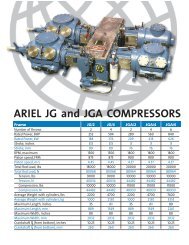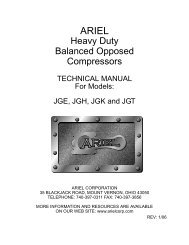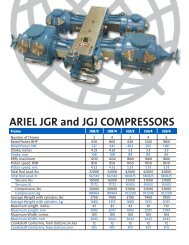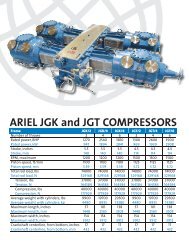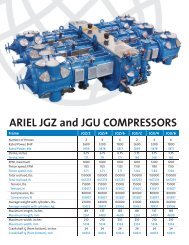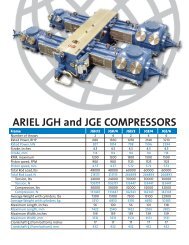Heavy Duty Balanced Opposed Compressors
Heavy Duty Balanced Opposed Compressors
Heavy Duty Balanced Opposed Compressors
You also want an ePaper? Increase the reach of your titles
YUMPU automatically turns print PDFs into web optimized ePapers that Google loves.
FOR MODELS: JG AND JGA SECTION 5 - MAINTENANCE<br />
crankshaft level. Wear gloves to avoid being cut by the slinger and to achieve a<br />
good grip. The gloves should be clean to avoid marring of the running surface.<br />
As the shaft is being slowly raised, the drive and auxiliary ends should be lifted<br />
at the same rate. Again, care must be taken to avoid marring the crankshaft surfaces<br />
by carefully guiding the crankshaft.<br />
Crankshaft - Oil Slinger<br />
Removal<br />
Although the slinger should last indefinitely with proper care, it can become nicked. Should it<br />
need replacement, suspend the crankshaft on a sling(s) as in “” on page 5-8 and heat the<br />
slinger to 400° F (240°C). It will attain a yellow glow at this temperature. When it has<br />
expanded it should fall off by itself. DO NOT TOUCH HOT SURFACES WITHOUT PROPER<br />
INSULATION TO PREVENT INJURY.<br />
Installation<br />
Put a rod at least 1/2 inches (13 mm) in diameter through the slinger. (Special care should<br />
be exercised when handling the slinger, not only to keep its surfaces unmarred, but to avoid<br />
being cut by the outer sharp edge.) After the slinger is suspended heat it with a small torch.<br />
When it has attained a yellow glow, approximately 400° F (240°C), it can be slipped over the<br />
drive end of the crankshaft. Hold the slinger in position with high temperature gloves or two<br />
pieces of clean wood, rotating it slightly to make sure it is square, until it has cooled enough<br />
to shrink onto the crankshaft. DO NOT TOUCH HOT SURFACES WITHOUT PROPER<br />
INSULATION TO PREVENT INJURY.<br />
Crankshaft - Chain Sprocket<br />
Removal<br />
Examine the sprocket carefully for signs of wear. If it has been in operation for five years or<br />
more, it may be convenient to replace it if the crankshaft is removed from the frame.<br />
Drill a hole in the sprocket hub. This hole should be parallel to the shaft centerline and big<br />
enough that it removes most of the hub cross section. (See Figure 5-6:) Be careful not to<br />
touch the shaft with the drill. Mark the drill with tape so you do not drill through the sprocket<br />
and into the crankshaft face.<br />
PAGE 5 - 10 11/01





